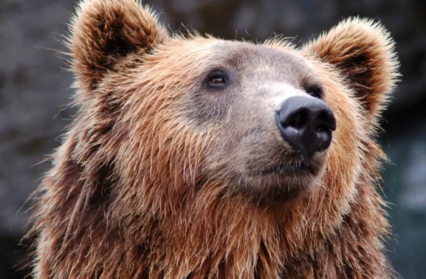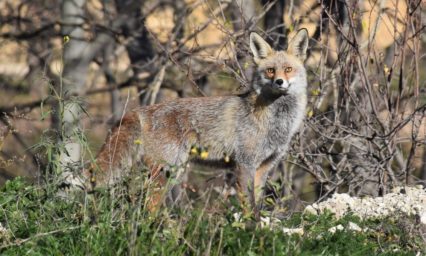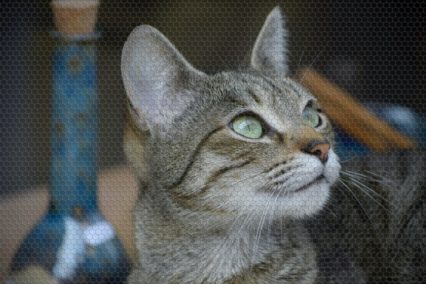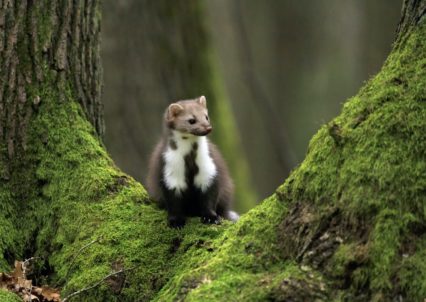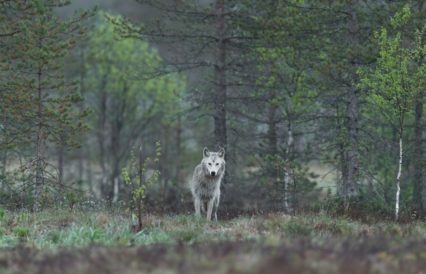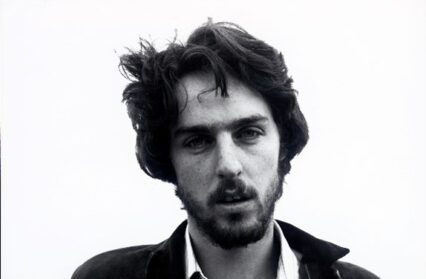What is the strange yet profound feeling we experience during fleeting encounters with animals in the wild? Here, Richard Gwyn explores the concept of the entrancing ‘animal gaze’ and considers the depth and breadth of such interactions.
‘All things long to persist in their being; the stone
eternally wants to be a stone and the tiger a tiger.’J.L Borges.
The black bear appeared out of the woods to my left and lumbered across the highway, just ahead of me. It was early morning and the shadows were long. I pulled over, crawled beside the guard rail, and spotted it again; an adult male, I guessed, from its size and the shape of its head. He had crossed the deep ditch beside the road and was climbing, foraging on the grassy hillside about fifteen metres away.
I was drawn to him by some elemental gravity, a force beyond reason. Something remote yet familiar stirred and fluttered between us and was carried on the air with the scent of juniper. The bear raised his head, kept his gaze on me for a brief spell, but he wasn’t especially interested, and his snout returned to the flower which he had been sniffing with devout attention before he looked up. He took his time. He wasn’t bothered by my presence nearby. He ambled slowly up the hillside, out of sight, and I got back into the car. Watching this animal, I was completely entranced, outside of time. I had been drawn towards the bear in a way that, afterwards, I tried to explain, but could not. Words failed me utterly.
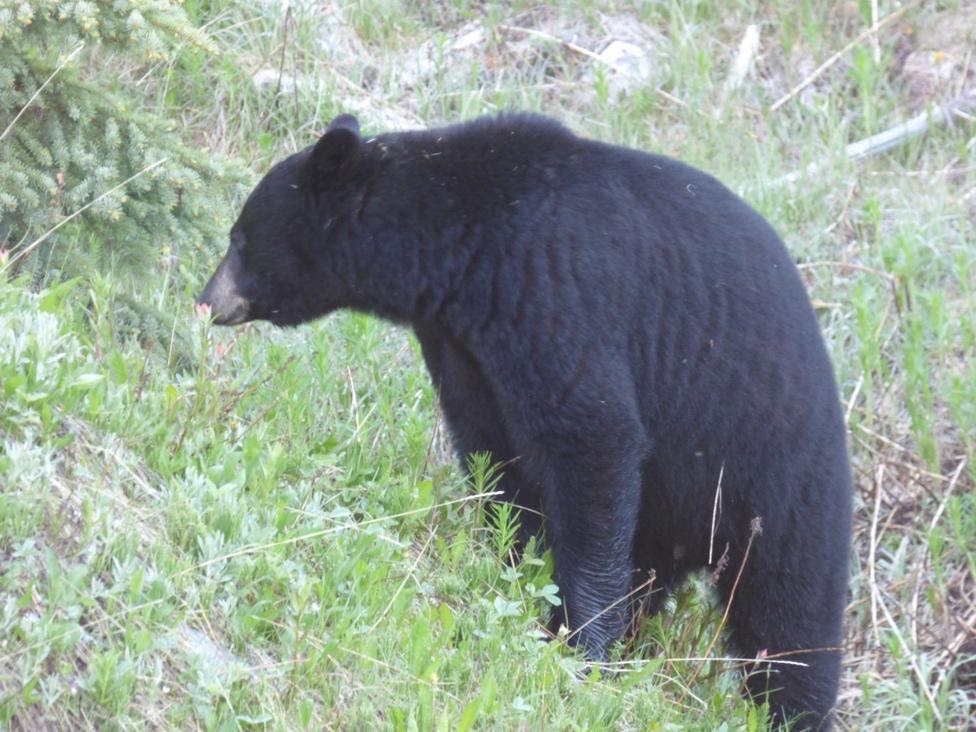
This encounter in the Canadian Rockies, however fleeting, filled me with a kind of awe, which I struggled in the following days to comprehend. I had not really been in any danger, and the bear, as I have said, seemed to be more interested in sniffing the flowers than in anything I was doing. But nonetheless, something had passed between us, and I explained it to myself and to my friends, back in Banff, in what might have seemed inflated or grandiose terms. The truth was, I felt suffused at the time, and for a couple of days after, by something like deep contentment, even love; as if I had not only learned something about the gaze that passes between human and animal, but equally about my deeper self – what I can only call the soul – and in a way I had barely considered before, but had always known.
What was the nature of this thing that passed momentarily between us, which for want of any other name I call the animal gaze? In the eighth of the Duino Elegies, Rilke writes ‘And yet, sometimes a silent animal looks up at us and silently looks through us.’ The bear looked through me, and I was going to write almost as though I was not there. But that is not quite right. The animal gaze may be indifferent, but is not oblivious.
I recall other instances when I have been a recipient of the animal gaze, or participated in an exchange of gazes with an animal in the wild. A fox crosses the field just ahead of me, catching my scent on the breeze, and turning his head, he stops suddenly, mid-step, one of his front paws raised in a characteristic pose, snout turned towards me, long whiskers twitching, alert and questioning. The passage of a few milliseconds as we assess each other, before he sets off on his way. That rupture in time’s narrative, that sudden hiatus as one creature enters another’s world unexpectedly, an animal going about its business, never expecting a human to appear. Whenever an encounter of this kind occurs, it is entirely new and unexpected. It feels like time out of time. I have come face to face with deer and boar while hiking in the Pyrenees, and almost always there is a moment of surprise, or shock, followed by a sort of mutual acknowledgement, before each of us goes our separate way. There are exceptions: once, last year, I disturbed a boar sow with attendant cubs, who, on seeing me, emitted a threatening growl. No time to examine the nature of the gaze then; the message was clear enough. She would certainly have charged me, had I lingered.
Among those writers who evoke our relationships with animals in the wild is Jean-Christophe Bailly, who offers a compelling account of the author driving at night along a country road and encountering a solitary deer:
A deer has come out of the undergrowth; frightened, it runs up the road, trapped between hedgerows: it too is caught in the estuary. It rushes ahead, just as it is, just as it has to be – fear and beauty, quivering grace, lightness. The driver, going slowly now, follows the creature, watches its croup move up and down, bounding in its dance. A kind of hunt is under way, in which the goal is not – certainly not – to catch up, but simply to follow, and since this race takes longer than one might have imagined, several hundred metres, a strange joy comes, childlike, or perhaps archaic. Finally, another path opens up for the animal, and after hesitating ever so slightly the deer plunges in and disappears.
It is this ‘strange joy’ that Bailly describes — childlike, or archaic — that I recognise, and want to think about, to write about . . .
In his essay, published in English as The Animal Side, Bailly recognises his reaction to the deer, but nevertheless is ‘taken aback, overcome. The sequence had had the clarity, the violence, of an image in a dream.’ He ponders what has happened during this bizarre chase, as the driver pursues the deer down the road, and concludes that he has touched some part of the animal world . . . with his eyes. He knows this is impossible, in any literal sense. He hasn’t entered the animal’s world but rather the strangeness of that world has revealed itself to him once more, ‘as if I had actually been allowed for an instant to see something from which, as a human being I shall be forever excluded . . . a strangeness [that] ought to be considered on its own terms, as a different posture, a different impetus, and quite simply a different modality of being.’ And he confesses that this experience moved him to tears, a sentiment which, after my encounter with the bear, I fully understand. It was, he says, ‘both like a thought and a proof that there is no supremacy, neither of humans nor of beasts, that there are only passages, fleeting sovereignties, occasions, escapes, encounters. The deer was in its night and I in mine, each of us alone.’
Is it, then, something to do with a quality of aloneness – the bear (fox, deer, or boar) in its world and I in mine – that reinforces my sense of having been granted, briefly, an opening into another world: a sense of origin, of something deeply remembered, though now forgotten?
What I earlier termed ‘love’ with regard to the bear, and the corresponding sentiment – a realisation of transience (‘fleeting sovereignties, occasions, escapes, encounters’) that produced tears in Bailly – might be pertinent to the topic that he addresses next in his essay. He writes that ‘declarations of intense feelings on the subject of animals quite often not only fall flat but give rise to a sort of embarrassment.’ This is a murky area, in which one might be accused of sentimentality, since most people regard a love of animals as something quite childish, a consequence perhaps of the general Disneyfication of our engagement with ‘the animal kingdom’ (this term itself is worthy of attention, with its neatly superimposed monarchical assumptions). But what I am talking about here is as far as imaginably possible from a Disneyfied attitude of cuddly objectification. While we have confined beasts into manageable conceptual spaces – domesticated animals as pets in the home, wild animals in zoos – we have retained a profoundly ambiguous relationship to them in our thoughts and in our dreams. Animals will not stay put in their allocated place. They have continued, without even trying, to make the boundary between their worlds and ours an unsettled and unsettling one. Every animal encounter of the kind that I have described evokes a reaction of loss, and reminds us of something that surpasses the individual and yet is somehow integral to our humanity.
While Jean-Christophe Bailly’s essay speaks directly to the experience of encounters with animals in the wild, John Berger, in his essay, ‘Why Look at Animals’, reminds us of the more complex and elusive relationship between humans and animals that have been kept in captivity, either as domesticated farm animals, as pets, or else on display in zoos. He starts out by claiming that for most of human history animals constituted the first circle of the world that surrounded us. Indeed, that statement already suggests a distance that was barely apparent in the pre-industrial world; after all, animals and humans lived cheek by jowl. It is true, writes Berger, that such centrality was often ‘economic and productive’, since humans depended on animals for food, work, transport, clothing. But to imagine that animals ‘first entered the human imagination as food or leather’ would be to ‘project a nineteenth-century attitude backwards across the millennia.’ Long before then, animals held a symbolic and magical value; they were good to think with, in Lévi-Strauss’ phrase, rather than merely resources to consume.
Berger then goes on to make an unusual point about the look that passes between animals and humans in the wild (which he later contrasts with the looks exchanged between humans and animals held in captivity, notably in zoos). When humans and animals look at each other, the human recognises the animal’s look as ‘familiar’, he writes. ‘Other animals are held by the look. Man becomes aware of himself returning the look.’ In other words, as I suggested in my encounter with the black bear, a kind of power is ascribed to the animal through this exchange of looks, ‘comparable with human power but never coinciding with it.’ The observed animal has secrets which are addressed specifically to us. ‘The animal has secrets which, unlike the secrets of caves, mountains, seas, are specifically addressed to man.’ It is because of this ability to recognise ourselves in this other creature that a companionship can arise between humans and animals: ‘with their parallel lives, animals offer man a companionship which is different from any offered by human exchange. Different because it is offered to the loneliness of man as a species.’
But it would be foolish to read too much into the relationship between a human and an animal in the wild, or to read the wrong kinds of messages into the gaze that is exchanged between them. Such was the case with dim-witted Timothy Treadwell, the subject of Werner Herzog’s documentary film Grizzly Man. Treadwell was a New Age voyeur who believed that he was in touch with his inner bear, but only succeeded in getting himself and his girlfriend, Amie Huguenard, killed and eaten by one. His story, according to Werner Herzog’s film, based on Treadwell’s video footage, was ‘a tragic misunderstanding of what wild nature is all about’. ‘What haunts me’, Herzog adds, in his commentary towards the end of his film, ‘is that in all the faces of all the bears that Treadwell ever filmed, I discover no kinship, no understanding, no mercy. I see only the overwhelming indifference of nature.’ Treadwell’s tale is salutary, and his ending is summarised accurately, if brutally, by a park warden in Herzog’s film: ‘he got what he was asking for, he got what he deserved.’
While animals have served as metaphors for human character traits, humans have also likened themselves to animals (Aesop, La Fontaine, Beatrix Potter, Disney); thus has anthropomorphism flourished over the centuries. But in parallel with this, as we celebrate their alleged ‘human qualities’ – or the corresponding ‘animal qualities’ of humans – we have, for the most part, lost the habit of interacting with animals themselves. Most children today, growing up in cities, have never seen an animal in the wild, in its natural habitat. Probably they never will.
The result of this detachment from nature and wildness (and a direct consequence of the overcompensation it occasions) is that people have begun to regard animals nostalgically, and the animal has become, in Berger’s phrase ‘emptied of experience and secrets.’ It is this new, invented ‘innocence’, argues Berger, ‘that provokes in man a kind of nostalgia.’ It is almost as if, in a deranged act of housekeeping – of ‘keeping the wilderness at bay’ – we have divested ourselves of all that pertains to our animal selves, with the result that we are left only with cardboard cut-outs of the animals we once lived alongside. The animals have thus become caricatures, not of themselves, but of us. So it is that we must consider pets (the term ‘pet’, Berger tells us, once referred to a lamb raised by hand in the household). The acquisition of pets, incidentally – especially cats and dogs – has undergone a massive surge during the coronavirus pandemic, as thousands have attempted to acquire or purchase animal companions, apparently to lessen their own sense of loneliness. The past year has also seen a burgeoning black market in stolen pets, especially the cuter breeds of dog.
In the past, as Berger reminds us, people kept domesticated animals for specific purposes – guard dogs and hunting dogs, cats for controlling rodents – but nowadays pets are household trophies, a distinguishing feature of consumer societies. I can remember how, forty years ago, in rural Spain, practically no one kept a dog as a pet; nowadays every household seems to own one. Berger describes the setting in which the pet survives: ‘The small family living unit lacks space, earth, other animals, seasons, natural temperatures, and so on. The pet is either sterilised or sexually isolated, extremely limited in its exercise, deprived of almost all other animal contact, and fed with artificial foods. This is the material process which lies behind the truism that pets come to resemble their masters or mistresses. They are creatures of their owner’s way of life.’
The pet also serves another function. It offers its owner a mirror to a part of himself or herself of which only that person is aware. But this relationship, in which each party reflects the other, has none of the satisfying parallelism that marks the separateness of animal and human lives. It creates a new nostalgia, growing out of the domesticity that binds them together: a nostalgia for the wild.
But what is the ‘wild’? It’s a horribly overused word at present. Titles of books and documentaries celebrate wildness and ‘re-wilding’ abound, and the other morning I caught the opening exchanges, on BBC Radio Four Woman’s Hour, of an interview with Glennon Doyle, author of Untamed, a book about getting in touch with our inner wildness. Start to ‘untame’ yourself, Doyle’s webpage urges readers: ‘We’re born with these wild, individual selves and then we start to just give up who we are . . . We lose our wild selves, and then we have to reverse the process so we can reclaim some of who we are or were before the world told us who to be.’ The ‘wild’ person is ‘who we are’, and ‘wildness’, we are told, is an inherent quality to which we have rights, and which has somehow been taken from us, rather than willingly surrendered.
Annie Dillard’s famous essay ‘The Weasel’ begins with the declaration: ‘A weasel is wild. Who knows what he thinks?’ and goes on to recount a story about a man who shot an eagle from the sky and discovered the dry skull of a weasel attached to the bird’s throat, the assumption being that the eagle had once pounced on the weasel, which had turned and sunk its teeth into the bird’s neck, to be carried thus for the weeks or months or years until the bird was brought down from the sky. The rest of Dillard’s essay purportedly explores the notion of ‘wildness’, focusing at one point on the moment when the writer herself comes face to face with a weasel: ‘The weasel was stunned into silence as he was emerging from beneath an enormous shaggy wild rose-bush four feet away. I was stunned into stillness, twisted backward on the tree trunk. Our eyes locked, and someone threw away the key.’ Dillard makes the most of the moment: ‘Our look was as if two lovers, or deadly enemies, met unexpectedly on an overgrown path when each of them had been thinking of something else: a clearing blow to the gut. It was a bright blow to the brain, a sudden beating of the brains, with all the intimate grate of rubbed balloons. It emptied our lungs. It felled the forest, moved the fields, and drained the pond; the world dismantled and tumbled into that black hole of eyes.’
Not satisfied with a blow to the gut, Dillard invokes a beating of the brains and an emptying of the lungs as well. I cannot help but wonder whether the weasel underwent equivalent anatomical distress. Dillard assures us that he did: ‘I tell you I’ve been in that weasel’s brain for sixty seconds, and he was in mine.’ I am not convinced by this, however; my guess is that the weasel, like my bear, looked through her. They were not like lovers, or deadly enemies meeting unexpectedly on an overgrown path: that is all human interjection. Fortunately, Dillard relents towards the end of the encounter: ‘What does a weasel think about? He won’t say. His journal is tracks in the sand, a spray of feathers, mouse blood and bone: uncollected, unconnected, loose-leaf, and blown.’ And here we come to the crux of the matter. All those words Dillard employs to convey the utter confusion of her side of the encounter (damage to gut, brains, lungs) is reduced, on her creature’s part, to a list of weaselly phenomena – the bits and pieces that furnish a weasel’s day (tracks, feathers, blood and bone). A phenomenology of death. Dillard’s account, despite its title, is not really about a weasel; it is about Dillard. She wants to be wild, and has come to live in this place in order to learn from the weasel: ‘The weasel lives in necessity and we live in choice, hating necessity and dying at the last ignobly in its talons. I would like to live as I should, as the weasel lives as he should: open to time and death painlessly, noticing everything, remembering nothing, choosing the given with a fierce and pointed will.’ It seems to me that this admiration for the weasel’s wildness, as exemplified by its tenacity in hanging on like grim death to the eagle’s throat, is not that far removed from the narrative of the American Dream: to ‘grasp your one necessity and not let it go’, as Dillard puts it, a call to indomitable tenacity and heroic individualism; and that is why it is admirable and acts as a kind of incentive to greater achievement. Dillard’s essay serves as an example of how easy it can be to conflate ideas about ‘wildness’ and the requirements of the ‘self’. It is an error that neither Bailly nor Helen Macdonald makes.
At the time of my encounter with the bear I had been reading Macdonald’s memoir H is for Hawk and had been moved by the way the author synthesised and channelled emotions of grief at the loss of her father though training a young goshawk. I too had recently lost my father, and her story resonated with me. I too had felt an unfathomable pull towards the natural world, and animals in particular, following his death, and in a way that I found very hard to explain or account for.
At one point in her book Macdonald writes of her growing understanding of the hawk, Mabel: ‘I am becoming fascinated by her quality of attention. I’m starting to believe in what Barry Lopez has called “the conversation of death”, something he saw in the exchange of glances between caribou and hunting wolves, a wordless negotiation that ends up with them working out whether they will become hunter and hunted, or passers-by.’ Again the exchange of glances, that moment of time out of time as two creatures assess each other. I remember a friend, the novelist Tristan Hughes, mentioning an unexpected encounter with wolves, near his home in remote Northern Ontario. I email him, curious to know whether he too experienced a moment of hiatus, a suspension of normal time, while the wolves and he measured each other up. His answer comes back after a couple of hours:
I was making my way through the dead grass at the edge of a beaver pond when I looked up over the top of the grass and found them directly in front of me. I’d had no clue or indication of their presence until I saw them. There were three of them, two grey ones and a black one in the centre. They were no more than twenty yards away.
There was, just as you describe it, a kind of paralysis of time (I’ve no idea how long the encounter lasted), and one that took on a physical aspect too – on my side anyway. There was a sudden and intense narrowing of focus, a sort of tunnel vision; it was like my brain had performed an instant bit of triage – there was only one urgent thing in the landscape, and all my senses were bent to it. And that hyper-awareness or focus seemed to put everything into a kind of slow motion (a trick of adrenaline, I guess, to increase the ability to react). And then, another effect of adrenaline. The cliché is ‘spine-tingling’ but that is exactly what it was: a million-year old mammal response; the memory of being prey. There was also a momentary paralysis or hiatus in cognition. For a few jumbled milli-seconds the cultural reference points or iconographies of wolves weren’t in place – I knew they were wolves, but I didn’t know them as wolves. Instead, for those few instants, my mind seemed to break them down into essential qualities: they were big, they were grey and black, they had yellow eyes – and those eyes were looking at me.
As for the way they were looking at me, I’d probably describe it as a mixture of curiosity and indifference. They must have known I was there for a while, through scent, and worked out I was no threat to them and wasn’t food. Getting sight of me fulfilled no function or need – they just wanted to look. And once they’d looked for what felt like a long time, but could only have been twenty or thirty seconds, they moved slowly away into the woods, as though I were something unusual thrown up on a beach – an interesting piece of flotsam to be examined, noted, nudged with a toe, and passed by.
The indifference of Hughes’ wolves not only evokes, for me, the reaction of my black bear, but ‘indifference’ is Herzog’s chosen descriptor for the faces of ‘all the bears ever filmed’ by Timothy Treadwell. John Berger, in another essay, defines nature’s energy as ‘fearsomely indifferent’, contrasting it with the sentimental view of nature often produced by urbanites, who regard nature as ‘a garden, or a view framed by a window, or as an arena of freedom.’ Berger’s view of nature, of ‘the wild’, is not only indifferent, but unmistakably bleak: ‘The gale blows itself out, the sea changes from the colour of grey shit to aquamarine. Under the fallen boulder of an avalanche a flower grows. Over the shanty town the moon rises. I offer dramatic examples so as to insist upon the bleakness of the context.’
What we are in relation to a natural, wild landscape, a wild creature, or creatures, is something we, as humans, have almost entirely lost sight of: in Bailly’s phrase, our eyes no longer touch those creatures, that world. A sense of perspective is lacking; we forget our own smallness and fragility below the vast and indifferent shift of the skies, in the tremors of an earthquake, or in the approach of a storm. Perhaps only in encounters with the wilderness do we feel our true status as creatures.
In Helen Macdonald’s book, there is another story, concerning the caves at Lascaux, which immediately attracted my attention. I was fortunate enough to have visited the caves at Lascaux as a young child, shortly before they were closed to the public – an event which made a lasting impression on me. Macdonald remembers that when she was at junior school, a teacher showed her and her classmates photographs of the cave paintings at Lascaux, and explained that no one knew why prehistoric people drew these animals. ‘I was indignant,’ she writes. ‘I knew exactly why, but at that age was at a loss to put my intuition into words that made sense even to me.’
How could the teacher not see? How could the teacher not understand the obvious interdependence between our ancestors and the animals that surrounded them? I recall our family visit to Lascaux but only return to images of darkness and a vague sense of wonderment at the beautiful shape of an animal, a bison, on the wall of the cave. I try my best to remember more but draw a blank; what I can recall is a very bright light – a spotlight – and warm, harmonious colours, reminiscent of the colours of the earth; but then again I have seen so many reproductions of the Lascaux caves that I have no idea if that memory is truly my own, or borrowed, so I message my sister, who is six years older than me, and ask her if she has any memories of our visit to Lascaux caves in 1962. At the time she gets my message – in one of those rare instances of synchronicity – she is packing a present to send to her grandson, Leonardo, in Los Angeles. It is a book called Cave Baby, in which – she sends me a photo of the relevant page – the baby’s mother paints the walls of the cave with bison and deer.
She also sends an extract from her scrapbook of the family holiday to France in the summer of 1962. Of course, our father had insisted she keep a record, as he always did of my older siblings on these trips. I learn from this, which she photographs and sends on WhatsApp, that the cave was discovered by four boys and a dog in 1940. My sister’s best eleven-year-old scrawl records that: ’The cave was lit up and looks very nice’, before continuing: ‘The drawings are of many ages and are the colours yellow, red and black ochre.’ In a final comment, she adds that ‘two of the boys who discovered it are now the present guides.’
I am trying to piece together parts of a puzzle: it is not only what I seem to recall from my visit to the Lascaux caves as a six-year old, but also the joy intuited by Macdonald in her childhood classroom, and quashed by her teacher’s remark that ‘no one knew why prehistoric people drew animals.’ It is the same joy I experienced on seeing the black bear.
Of course we knew why people painted on the walls of their caves! Children, perhaps, more than anyone else: we know it in the very fibre of our being. We need to draw the animals, and to sing the songs of the animals and dance their dances in our rituals, for a very simple reason: we recognise them as both ourselves and as other, a simultaneous perception of identification and of othering; the elemental you and I, perceiver and perceived; the subject and object of all encounters. The essential paradox of being.
Our ancestors were not only fascinated by these creatures who lived their lives in parallel with their own, and with whom they had a pact of sorts. They also loved them. This love is visible in the paintings so tenderly crafted, which in a modern-day observer stirs a sense of a forgotten intimacy, of profound loss. Bailly again: ‘Leaving aside the dispute over the sacred to which these wall paintings inevitably lead, we can nevertheless say that they point to an origin or an originary state of designation, and that they can be understood as a first, stupefying recording in which, at the heart of nature as a whole, the animal is recognised as the great other, the first companion.’
We needed to invoke, to translate that other; the fox, the bear, the bison, the deer, through what would later be termed sympathetic magic. We still need to translate them. They are our others and we need to translate them onto the walls of our modern caves. The cave paintings of Lascaux and elsewhere record that reciprocal gaze in a fashion that seems to me exemplary; the animal is simply there, and the painter is looking at them as things of wonder. What do I conclude? That while animals have not forgotten how to look at us, we may have forgotten how to look at animals.
Troubled and troubling it may be, but these animal encounters lie at the heart of so much that we human animals experienced, day in, day out, over a few million years of evolution, for most of which time such thoughts were integral to everyday existence. The creatures we shared our world with – that same world we have ruthlessly plundered and are in the process of destroying – also help to remind us how to live. Or, as Anne Dufourmantelle puts it in her book, Gentleness, the animal disarms our sense of duplicity, because we humans are divided, in exile from ourselves, whereas an animal’s gentleness ‘comes to us from a being that coincides with itself almost entirely.’ This is not a question of consistency of ‘self’ or existential solidity, but simply of being true to one’s own nature, as a stone is a stone and a tiger is a tiger. To coincide with oneself almost entirely.
Richard Gwyn is a regular Wales Arts Review contributor. His latest novel, The Blue Tent (Parthian), and latest poetry collection, Stowaway: A Levantine Adventure (Seren), are both available now.
Recommended for you: Wales Arts Review’s Flash Fiction collection featuring original works from Cynan Jones, Nigel Jarrett, Richard Gwyn and many more of Wales’ best literary talents.


